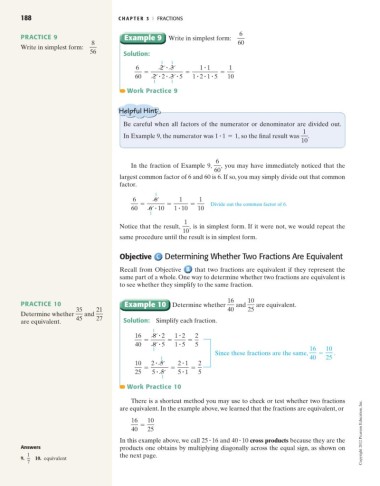Page 211 - Basic College Mathematics with Early Integers
P. 211
188 C HAPTE R 3 I FRACTIONS
6
PRACTICE 9 Example 9 Write in simplest form:
8 60
Write in simplest form:
56 Solution:
1 1
#
#
6 2 3 1 1 1
= = =
# # #
# # #
60 2 2 3 5 1 2 1 5 10
1 1
Work Practice 9
Be careful when all factors of the numerator or denominator are divided out.
1
#
In Example 9, the numerator was 1 1 = 1, so the final result was .
10
6
In the fraction of Example 9, , you may have immediately noticed that the
60
largest common factor of 6 and 60 is 6. If so, you may simply divide out that common
factor.
1
6 6 1 1
= = = Divide out the common factor of 6.
#
#
60 6 10 1 10 10
1
1
Notice that the result, , is in simplest form. If it were not, we would repeat the
10
same procedure until the result is in simplest form.
Objective Determining Whether Two Fractions Are Equivalent
Recall from Objective that two fractions are equivalent if they represent the
same part of a whole. One way to determine whether two fractions are equivalent is
to see whether they simplify to the same fraction.
16 10
PRACTICE 10 Example 10 Determine whether and are equivalent.
35 21 40 25
Determine whether and
45 27 Solution:
are equivalent. Simplify each fraction.
1
#
#
16 8 2 1 2 2
= = =
#
#
40 8 5 1 5 5
1 16 10
Since these fractions are the same, = .
1 40 25
#
#
10 2 5 2 1 2
= = =
#
#
25 5 5 5 1 5
1
Work Practice 10
There is a shortcut method you may use to check or test whether two fractions
are equivalent. In the example above, we learned that the fractions are equivalent, or
16 10
=
40 25 Copyright 2012 Pearson Education, Inc.
#
#
In this example above, we call 25 16 and 40 10 cross products because they are the
Answers products one obtains by multiplying diagonally across the equal sign, as shown on
1 the next page.
9. 10. equivalent
7

